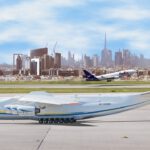The Silk Road, the ancient network of trade routes stretching across Eurasia connecting the east to the west, was named by German geographer and traveller Ferdinand von Richthofen in 1877.
But it has existed since the third century BC, and was used regularly from 130 BC, when the Han Dynasty officially opened trade with the west. It’s not a single track stretching from China to the west, but rather a network of routes and alignments that crisscross the Asia-European axis.
Last week, I visited a remote part of north western China that was, if not the start of the Silk Road, part of its eastern extremity. The visit was organised by a former colleague and good friend who now runs a private equity real estate business with sizable activities in China.
I went to the far northwest of Xinjiang Province, to a small finger of land that borders Mongolia, Russia and Kazakhstan. The region contains the Altay mountains, a chain of mountains that stretches several hundred kilometres through China and Russia.
Xinjiang Province is important for many reasons. First, it is a very large province, making up one-sixth of China’s total land area (it’s as large as Indonesia). But it’s sparsely populated, accounting for only 1.6 percent of China’s population.
Second, the region’s history is very different from most of China, as are its original peoples.
Xinjiang is home to several ethnic minority groups, the most well-known being the Turkic Uighur (pronounced “weega”) people. From being a significant majority of the population a generation ago, the roughly nine million Uighurs now represent just 41 percent of the province’s population today. That’s because the Chinese government has encouraged its native Han people to populate the region in increasing numbers.
Xinjiang is officially called the Xinjiang Uighur Autonomous Region, but it’s easy to question the “autonomous” part of that label.
The province is deemed a major security risk by China’s leaders because of a strong separatist movement that is seeking full autonomy from China.
That is reflected in life and travel restrictions throughout the region. As we drove across the province, we had to stop for security checks and searches every hour or so.
Entering just about any building (including roadside toilets) involved passing through an x-ray machine and, frequently, a pat down by a police or army detail. All bags and luggage of any kind go through endless x-ray machines.
Xinjiang is big, and China has invested heavily in building highways across the province. But getting anywhere, even with the good roads, takes hours and hours of driving… across varying forms of desert, steppe lands and mountains (largely filled with, well, not very much).
But what is there is curious…
Power generation… of all types
The desert to the northwest of Urumqi, the capital, is dotted with coal-fired power stations located in the middle of nowhere. There are no towns or cities anywhere nearby. But there is coal.
The decision makers elected to build near the coal, and then transport the electricity – rather than the other way around.
As a result, much of the desert and steppe lands are criss-crossed with endless pylons carrying power cables east and south, feeding the ever-growing demand for electricity in the more densely populated regions.
But it is not all coal-fired stations. There are also hundreds, if not thousands, of huge wind turbines dotted across various parts of the desert. Xinjiang stands as a testament to China’s growing development of renewable energy sources. And there are millions more acres that could be home to even more turbines.
And then there is oil… miles and miles of nodding donkey rigs across the steppes.
Equally curious are the randomly located smoke stack industrial plants, plonked in the middle of the desert, miles from anywhere, with nothing around them but a connecting road or track.
Many, I was told, are mining establishments… some involving rare earth minerals. We passed many a flatbed truck carrying loads of aluminium ingots and other metals.
More resources
This was all before we looked at the parts of the steppes that are farmed. The region is a major producer of cotton, with cotton fields stretching for miles. Much of it is harvested using John Deere machinery.
Wheat, corn, melons and sunflowers are farmed in scale in various parts.
But for the most part, the landscape is untouched, unfarmed and home to nomads with herds of sheep, cattle, camels and horses. It is VERY empty.
The tourist hordes
Up in the mountains, things change. I am not sure what I was expecting, but what we encountered was certainly not anticipated: People. Large numbers of them. Tourists in the thousands, pouring through the mountains, the valleys and the river banks. This area is considered one of China’s natural landscape jewels. It is known to be a photographer’s paradise.
Our trip had also been timed to coincide with the dramatic changing of colour of the forests. It’s something truly beautiful to see, and an attraction for visitors for sure.
On top of it all, the trip took place just before the start of Golden Week, the national week-long holiday celebration of National Day.
It’s worth noting that in almost a week on the road outside the capital Urumqi, we only saw two other westerners. This area certainly isn’t part of the international tourism circuit.
We are increasingly seeing a large number of Chinese tourists venturing abroad. But here was the domestic version of this trend, in huge volume.
Camera makers are profiting
The and its growing appetite for travel both domestically and overseas must be providing a significant boost to camera makers.
The vast numbers of cameras being wielded was a real eye-opener to me. Yes, the area we visited is known to be a photographic gem from a natural environment perspective. But it seemed that about 90 percent of people there were toting cameras, and all seemed to be clicking away furiously.
My on-the-ground channel checks indicated two types of shutter bugs – those toting smartphones, and those lugging serious single-lens reflex (SLR) hardware, which I’d guess accounted for about half of all the cameras.
Canon Inc. (Tokyo Stock Exchange; ticker: 7751) was by far the dominant camera amongst this lot, with Nikon a distant second. Brands like Olympus, Sony and Fuji were barely in sight.
Canon is head and shoulders above the competition in most markets, but my observations suggest it’s ahead by an even bigger margin in China.
Where do the photos go?
Later, I got to musing about what happens to all the billions of pictures that get snapped every day. Because it is so easy (and so cheap) for shutterbugs to shoot endless pictures.
And they all get captured on endless, increasingly high-capacity chips. I am very confident that few of these images get edited or deleted or printed, for that matter. They are all kept in digital form for posterity. This means substantial storage requirements, especially for high-end photos that take up a lot of digital memory.
So suppliers of storage USBs and SD cards like SanDisk Corporation (NASDAQ; ticker: SNDK) must be rubbing their hands with glee at the surge in Chinese tourists and their natural propensity for the selfie.
I have noticed for many years that people in Asia LOVE to take photos of themselves, by the thousands, usually sporting a cheesy smile and a two-fingered victory sign. Attendance at every monument, every building, every meal, every natural landscape and every event needs to be recorded. It demonstrates I was there!
That cultural trait will persist.
It’s not just cameras and digital memory…
The Chinese tourist trend is also fuelling strong increases in demand for Boeing and Airbus, not to mention land transport like buses and trains.
Some suggest that China has overinvested in rail and road infrastructure. I don’t think so. Every time I travel to China I am surprised at how these new services and facilities have filled up and are increasingly jammed. Our two-hour traffic jam getting back into Urumqi, a small city by Chinese standards, tells me that most parts of China are far from saturated in terms of transport infrastructure.
There’s more to come…
So the Silk Road is alive and well. And it is now being given a new lease of economic life under the One Belt One Road initiative (OBOR).













